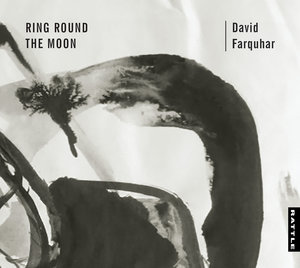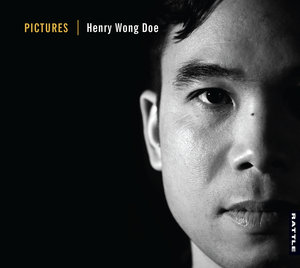DEBUSSY – Two Instrumental Sonatas and a Piano Trio
Violin Sonata in G Minor (1917)
‘Cello Sonata in D Minor (1915)
Piano Trio in G Major (1879)
Te Kōkī Trio: Martin Riseley (violin)
Inbal Megiddo (‘cello), Jian Liu (piano)
Rattle Records 0069 2017
JS BACH – Six Suites for solo ‘Cello BWV 1007-12
Volume One ( Suites 1-3)
Inbal Megiddo (‘cello)
Atoll Records ACD 228
Inbal Megiddo is presently the head of ‘Cello Studies at the New Zealand School of Music, Victoria University of Wellington, and has appeared in numerous concerts in Wellington both as a soloist and as a member of Te Kōkī Trio, an ensemble in which she is joined by two other faculty members, Martin Riseley, and Jian Liu, the respective heads of violin and piano studies at the school. Her career as a performer and teacher had previously taken her to various places throughout Europe, Asia and America before she came to New Zealand to take up a position at Victoria University’s Music School.
She’s now made recordings for Rattle, the first half of a set of Beethoven’s ‘Cello Sonatas with Jian Liu (the second disc is currently in preparation), and here with Te Kōkī Trio as listed above, in a recording of two of Debussy’s instrumental sonatas and his Piano Trio. She’s also recording for Atoll Records what’s intended to be a complete set of JS Bach’s Suites for Solo ‘Cello, the first disc of which is reviewed here. Prospective buyers may prefer to wait for her integral 2-disc set of these works, though people wanting a sample of her playing of this repertoire will be more than happy with this single CD, as the performances, to my ears, are strongly recommendable.
Recorded a year before the Bach/Atoll CD, the Rattle recording features Te Koki Trio, whose members variously bring together three chamber works by Claude Debussy. There are two instrumental sonatas from the composer’s last years, one for ‘Cello and Piano (1915) and the other for Violin and Piano (1917), the latter being the composer’s last completed work. The trio then comes together for the disc’s final work, an early Piano Trio (1879).
The Violin Sonata begins the concert, here given a strong and atmospheric performance by Martin Riseley (violin) and Jian Liu (piano), the opening, perfectly-poised piano chords straightaway taking us into the composer’s characteristic sound-world of wonderment, joined after a few seconds by the violin’s more questioning voice. As the first movement moves, kaleidoscope-like, through its different realms, the instrumental interactions change from assertion to surrender with easy mastery, all brought off beautifully by the players. The violin’s exotic-sounding inclination to slide between notes in two or three places add to the mystery of the discourse, as do the beautiful balances achieved between the two players in the softest moments, realising the composer’s flights of fancy with intense concentration and focus.
There are a couple of strangely protracted between-movements pauses on this recording, as here, sharpening the listener’s eagerness to engage with the rest of the work! The quixotic second movement then delivers us playing of such impish drollery at the beginning, I found myself smiling (sometimes out loud!) at the po-faced audacity of it all! But what melancholy both Riseley and Liu brought to the music’s lovely middle section! And how easefully they then charted the course as the music moved disconcertingly between humour and wistfulness over the final pages. The final movement opened in a dreamlike manner, before the instruments roused themselves with alacrity, the violin in particular rushing about, rather like a caged bird wanting to break free, and compelling its partner to dance. As everywhere, I liked the performance’s risk-taking with these volatilities, the various figurations delivered by the players with engaging spontaneity rather than mere crystalline perfection. Again, Debussy’s fertile imagination takes the music unexpectedly into sultry, suggestive climes, violinist and pianist relishing the volatility of it all, Liu’s piano suddenly scampering away, with Riseley’s violin in hot pursuit. The music returned to the movement’s opening “caged bird” energies, but then surprised the listener once again, as the violin slowed the note sequences down to become almost childlike in expression. After a final accelerando from the depths and back into the light, the players suddenly and exuberantly threw their notes skyward in a gesture of wry finality.
Where the Violin Sonata began pensively and poetically, the ‘Cello Sonata opened with solemn grandeur and ceremony, the piano preparing the way for the ‘cello to adopt a similar mode, though both players soon relinquished the grandeur for more poetic exchanges, Inbal Megiddo’s instrument singing in beautiful accord with Jian Liu’s well-rounded tones. How excitingly the two instruments then raced together, as if for possession of a hilltop or a favourite hiding-place, before stopping to fully relish the surrounding silent spaces, the soft playing of both cellist and pianist a breath-holding sequence of pleasure at the end!
Something of a “how-de-do” marked the exchanges at the second movement’s opening! – in pizzicato mode the ‘cello became a kind of conspirator with the piano’s terse utterances. Again in an exotic-sounding setting, the instruments whimsically switched from staccato/pizzicato to legato/arco, while exploring as many timbres in between as fell in with fancy, making for a somewhat hallucinatory ride through a dreamscape! Impulsively, the finale breaks the mood with lively figurations from both instruments, the energies then giving way to introspection throughout a central section, until Megiddo and Liu revitalised the music’s tumbling aspects with almost manic focus, to the point where the music suddenly cried “enough”, and curtly silenced their efforts.
Playing the disc to anybody unfamiliar with the music would probably invite shock and disbelief on the listener’s part upon being told that all three works presented here were by the same composer! As a demonstration of how much distance someone’s creativity can travel in a lifetime, Debussy’s Piano Trio of 1879 makes for a profound listening experience in retrospect, while remaining totally enjoyable on a visceral level. Its first movement is the longest of the four, a graceful Andantino with songful lines for each instrument, the material conventional, but with everything confidently and meticulously wrought. A whimsical Scherzo has an attractively exotic feel to its opening gait, its central Trio section given the right amount of contrasting sentiment and circumspection by the players – while the slow movement’s Andante Espressivo, again beautifully set out for the instruments, charms with its slightly perfumed lyricism, Te Kōkī Trio allowing the music to speak for itself within a salon-like context.
Marked “Appassionato”, the last movement works up an acceptably “charged” level of feeling within the music’s own range and scope, again impressing with its workmanlike construction and level of expression, and indicating something of the boy Debussy’s obvious potential as a creator in years to come. Full credit to Te Kōkī Trio for taking so much trouble with the work, here in Rattle’s crystalline recording, sounding gloriously prodigious, if a tad disconcerting regarding content, in the company of its two more sophisticated “latter-day” siblings!
Turning to the Atoll disc of Inbal Megiddo’s performances of the first three of JS Bach’s ‘Cello Suites, one encounters something of the rarefied world of Debussy’s late Sonatas in terms of the relationship between economy of means and richness of expression. Inbal Megiddo’s playing, recorded by Wayne Laird in the precincts of Stella Maris Chapel, at Seatoun, in Wellington, sounds equally as glorious, her characterful playing captured in all its variety of utterance as a truly lifelike
representation, which I can’t wait to hear again on completing my task of committing these thoughts regarding the disc to the record.
Megiddo’s performances are recorded in numbered order, so I began my listening with the Prelude of the very first Suite, a performance which combined heart and mind, reaching for its emotional points with such surety and purpose, while keeping the music’s structures intact – the figurations were at once surely negotiated and yet imbued with a sense of liberation which empowered the listener to surrender to the music and the playing with the utmost confidence. After a freely-flowing and fanciful Prelude, the Allemande continued the process of unlocking the music, drawing from the player such strength and confidence as to enchant the listener. The Courante combined forthright impulse and purpose with a sense of fun – an unbuttoning of joyful expression, music which here expressed the idea of life’s essential cheerfulness in the face of worldly troubles, rather as Schubert was wont to do in his music. The Sarabande, deeply-felt and long-breathed in its phrasing, was Romeo to the Courante’s Mercutio – the figurations here spoke of imaginings and projections of thoughts and feelings beyond earthly boundaries. The Menuets were properly contrasted, the first confident and eager in its deportment, and the second, contrasting dance its more circumspect side, the opening a descent rather than the upward-leaping figure of the first dance, the legato of the figurations adding to the solemnities. I liked the rustic twang of the repeated opening dance’s final phrase. Dance-like, too was the final gigue, the player vigorous but flexible in her trajectories, impulsiveness hand-in-glove with a teasing flexibility, the sounds of sympathetic strings activated adding to the warmth and bustle..
Suite No.2 begins with D Minor circumspection, the playing expressing a care for solemnity of mood which gave the music the feeling of a soliloquy, one rising to expressive heights with beautifully-phrased ascents towards long-held notes. The Allemande seemed no less serious at the outset, the figurations eloquently speaking with the tones of a philosopher, the repeats nicely hinting at variations in emphasis, setting nothing in stone, but seemingly open to conjecture. Impulsively interrupting the discourse, the Courante burst in, all elbows and knees, proclaiming action rather than thought, clearing the way for the somewhat ceremonial pronouncements of the Sarabande, grand and stately, though Megiddo’s repeat of the opening made one catch one’s breath at its extra “layered” quality, the second time round, the dynamics given more open spaces to explore. Megiddo warmed the music to its task in the second part, sharpening the intensities, while keeping the beautiful shape of the whole. She found positive minor-key purpose in the first Menuet, making the major-key relaxation in Menuet II a joy, and links these nicely to the Gigue in mood, the playing resonantly voiced, and almost peasant-ish, in some places, in its suggestion of a dance-like drone.
We got plenty of C Major splendour in Megiddo’s opening of the Third Suite, great, confidently-arched roulades of sound, and with the player not afraid to saturate the music’s tonal palate with richly-wrought repeated arpeggiations, fearlessly and generously generated for our pleasure. After this, the Allemande seemed more-than-usually light on its feet, putting the following Courante even more on its mettle, the energies playful and teasing, the tones adding different kinds of timbral emphases to the narrative, to “spice up” the story. Very free at the outset in the Sarabande, Megiddo gave the music a full-throated voice, before varying the intensity in the repeated passage, expressing the emotion, and then stepping back to re-experience its effect at a distance – in these measured, beautifully controlled sequences she seemed to play both player and listener roles, the music having transfixed both and bound them inextricably together. We then got two Bourees instead of Menuets (these always remind me of sailors’ dances!), the first of which Megiddo gleefully propelled through its figured routine, pausing for reflection throughout the second of the two episodes, and then returning to the more overtly physical of the dances with renewed vigour. But the most unbuttoned exuberance was left to the final Gigue, which here under Megiddo’s fingers swept everything before it in a torrent of unbridled joy and confidence, the music-making compelling in its detailings and infectious in the sheer elan of its execution. (Sustained applause!)

